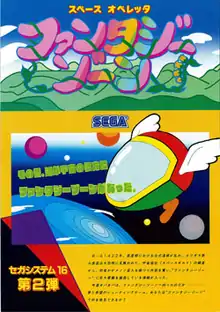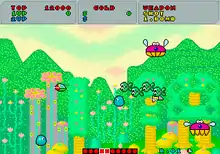Fantasy Zone
Fantasy Zone[lower-alpha 1] is a 1986 arcade game by Sega, and the first game in the Fantasy Zone series. It was later ported to a wide variety of consoles, including the Master System. The player controls a sentient spaceship named Opa-Opa who fights an enemy invasion in the titular group of planets. The game contains a number of features atypical of the traditional scrolling shooter. The main character, Opa-Opa, is sometimes referred to as Sega's first mascot character.[1]
| Fantasy Zone | |
|---|---|
 Promotional sales flyer | |
| Developer(s) | Sega |
| Publisher(s) |
|
| Composer(s) | Hiroshi Kawaguchi |
| Series | Fantasy Zone |
| Platform(s) | Arcade, Nintendo Entertainment System, MSX, Master System, PC Engine, Game Gear, Sharp X68000, Sega Saturn, Mobile phone, Nintendo Switch |
| Release |
|
| Genre(s) | Horizontal-scrolling shooter |
| Mode(s) | Single-player |
| Arcade system | Sega System 16A |
The game design and main character had many similarities to the earlier TwinBee, and together the games are credited with the creation of the cute 'em up subgenre.[2] Numerous sequels were made over the years.
Gameplay

In the game, the player's ship is placed in a level with a number of bases to destroy. When all the bases are gone, the stage boss appears, who must be defeated in order to move on to the next stage. There are eight stages, and in all of them, except the final one, the scroll is not fixed; the player can move either left or right, although the stage loops. The final level consists of a rematch against all of the previous bosses in succession before facing the final boss.
Opa-Opa uses two different attacks: the standard weapon (initially bullets) and bombs. He can also move down to land on the ground by sprouting feet and walking around until he flies again.
It is possible to upgrade Opa-Opa's weapons, bombs and flying engine to increase speed, as well as get extra lives. Before that, the player must get money by defeating enemies, bases or bosses, and access a shop by touching a marked balloon. Each time a new item is bought, they become more expensive. When the player chooses to exit or the time runs up, another screen appears, in which he or she can select what upgrades Opa-Opa can use; only one engine, weapon and bomb can be equipped at a time.
Some of the new weapons have a time limit that starts as soon as the shop is left. Some of the bombs can be used at any moment, but are limited in quantity. Engine upgrades are permanent. The powerups can also be reassigned by reentering the shop or touch a balloon with the word "Select" written on it. If the player loses a life, all of the upgrades are lost.
Ports
Fantasy Zone was ported to the Sega Master System, MSX, Nintendo Entertainment System, Sharp X68000 and PC Engine. While all of these ports play similarly to the original version, some of them have several omissions and changes. For instance, the Master System version lacks some features such as the radar that indicates the location of the bases or a gauge that indicates how much energy they have left, and two of the bosses were replaced by original ones.
Two different versions were released for the Famicom/NES. The Japanese version was released in 1987, developed and published by Sunsoft. The American unlicensed version was released in 1989, developed by Pixel and published by Tengen. In 1997, Fantasy Zone was released under the "Sega Ages" label in Japan for the Sega Saturn.
Fantasy Zone was later remade for the PlayStation 2, again under the "Sega Ages" label. Although similar in appearance to the arcade version (even incorporating the original arcade sounds), this version used polygons instead of sprites and added some stages, including bonus levels in which the game takes the view behind Opa-Opa as he tries to collect coins from any boss that was defeated at the moment; this game mode is very similar to Space Harrier, or the unreleased Space Fantasy Zone. This version was released in North America along other remade classic Sega titles in the Sega Classics Collection compilation.
Fantasy Zone was released for mobile phones in 2002 in Japan and in August 2003 in the United States. Due to hardware limitations, this version of the game was divided in three different parts. On March 11, 2008, the Master System version saw a re-release in Japan for the Virtual Console. In Europe and Australia, it was released on April 11, 2008, and in North America, on April 14, 2008.[3]
On September 18 of the same year, Sega released another Sega Ages disc devoted to the series, title Fantasy Zone Complete Collection, making the final release in the Ages series. This time, instead of a 3D remake, the disc compiled all of the games in the series, including spin-offs, and all of Sega's own ports. It also included a remake of Fantasy Zone II created for System 16 hardware.
The original arcade release is also included in Sonic's Ultimate Genesis Collection in which is an unlockable game. A 3D port of the game was released on March 19, 2014 for the Nintendo 3DS titled 3D Fantasy Zone: Opa-Opa Bros. New features of the 3DS port involve stereoscopic 3D visuals, adjustable difficulty settings, an ability to save the game, the ability to switch to the Japanese versions and US versions of the game, a Stage Select feature and a new mode which involves the player playing as Upa-Upa, Opa-Opa's brother. In addition, satisfying certain conditions during the game enables the player to confront the two "replacement" bosses from the Master System release, each entering the boss fight by literally "replacing" the standard boss.
The arcade version of Fantasy Zone is also included as a minigame in several entries in the Yakuza series, beginning with 2015's Yakuza 0.[4] It is identical to the original arcade release, with the only change being the addition of a rapid fire button.
Sequels
- Fantasy Zone II: The Tears of Opa-Opa (1987)
- Opa Opa (released internationally as Fantasy Zone: The Maze) (1987)
- Galactic Protector (1988)
- Space Fantasy Zone (1990, unreleased)
- Fantasy Zone Gear: The Adventures of Opa-Opa Jr. (released internationally simply as Fantasy Zone) (1991)
- Super Fantasy Zone (1992)
- Fantasy Zone (Redemption Game) (1999)
- Medal de Fantasy Zone (2012)
Reception
Fantasy Zone proved to be very successful in Japanese arcades, helping to give rise to the popular System 16 arcade board.[5] Despite this, the game was largely ignored by the gaming media, as were most arcade games at the time.
The game was reviewed in 1988 in Dragon #136 by Hartley, Patricia, and Kirk Lesser in "The Role of Computers" column. The reviewers gave the game 4 out of 5 stars.[6]
References
- Luke Plunkett (April 6, 2011). "Remembering Sega's Exiled Mascot".
- "Hardcore Gaming 101: Fantasy Zone".
- "Fantasy Zone and Mega Turrican Now Available on Wii Shop Channel!". Nintendo of America. April 14, 2008. Retrieved April 14, 2008.
- Brown, Peter (January 19, 2017). "Yakuza 0 Review". Retrieved December 15, 2017.
- "Game Machine's Best Hit Games 25 - テーブル型TVゲーム機 (Table Videos)". Game Machine (in Japanese). No. 282. Amusement Press, Inc. April 15, 1986. p. 21.
- Lesser, Hartley; Lesser, Patricia; Lesser, Kirk (August 1988). "The Role of Computers". Dragon (136): 76–81.
External links
- Fantasy Zone at Hardcore Gaming 101